ÇATALHÖYÜK 2005 ARCHIVE REPORT
| |
INTRODUCTION
Ian Hodder
New finds and new interpretations at Çatalhöyük
It is remarkable how new finds can challenge ideas that have been built up over many years. Çatalhöyük has been excavated now for several decades. First it was excavated by James Mellaart in the 1960s, and the current team has been working at the site continuously since 1993. Many theories about the site had settled down and have been taken for granted. But yet this year we found two objects which upset established views and forced us to reconsider some of our unquestioned assumptions. It is amazing what a few small objects can do.
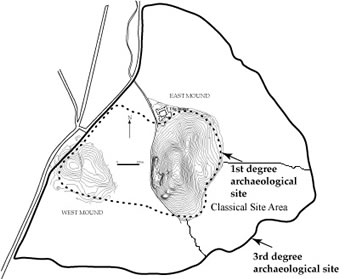
Figure 1 . Plan of 1ist degree protected area boundries of Neolithic East and Chalcolithic West mounds and approximate extent of Classical site within 3rd degree protection zone. |
120 people from all over the world assembled at Çatalhöyük again this summer. The team came from Britain, the United States, Iran, Romania, Serbia, Greece, Poland – in fact 13 different countries. All these people came to join Turkish colleagues working at the site. In addition to the Polish, US- and UK-based teams there are now two teams from Turkey working at the site. One, from Istanbul University and led by Mihriban Özbaşaran, has started work on the southwestern edge of the main East Mound. Their aim is to try to reach the lowest levels of the mound as they are interested in making comparisons with their excavations at the earlier sites of Aşıklı Höyük and Musular. The other, from Selcuk University in Konya and led by Ahmet Tırpan and Asuman Baldıran, plan to excavate the large historic site to the southeast of the East Mound (Figure 1). This year they began by doing surface survey and geophysical prospection. Together the Turkish and international teams have made some exciting new discoveries that are changing interpretations of this 9000 year old site in the Konya region.
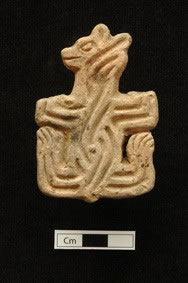
Figure 2. Clay stamp seal (11652.X1). |
One example of the new discoveries that have shaken our earlier assumptions is a beautifully made stamp seal (Figure 2), found in the fill of a Level V building in the South Area on the East mound. These stamps were probably used to stamp designs on skin or clothing. This example shows an animal with its front and hind legs raised upwards. Such figures have been known from Çatalhöyük for some time as plaster reliefs on the walls of houses. An example excavated by James Mellaart is shown in (Figure 3). These plaster reliefs have often been interpreted as ‘mother goddess’ figures. But the heads and hands of the plaster relief examples have always been cut off, so it was never possible to say whether the figures were humans or not. But now the stamp seal provides a key. Here the head and the hind paws remain. They clearly show that the figure is an animal, probably a bear. So it is probable that the reliefs with upraised arms and legs are not goddesses but bears. Depicting animals, such as leopards, in houses is common at Çatalhöyük, and so it is not surprising that we should find a bear. It has long been argued that some form of ‘mother goddess’ was central to the symbolism at Çatalhöyük, and these views were partly based on the interpretation of the reliefs with upraised arms as a woman. While it remains possible that the figures are ‘mother bears’ and representative of a female divinity, there is now little evidence that they are indeed women at all.
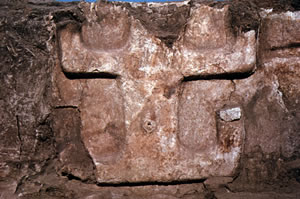
Figure 3. Excavated in the 1960s this example of a plaster relief has traditionally been interpreted as a 'mother goddess's' but perhaps interpretations need revising in view of the discovery of the clay stamp seal (11652.X1). |
Another important object this year that upset our long-held views was a clay figurine discovered by the Istanbul team in the burnt fill of a house (Figure 4). Immediately on finding the figurine we were all taken aback by its very strange and unusual imagery. The front of the figurine looks very much like the small, squat, so called ‘mother goddess’ figurines that are so well known (though rare) from Çatalhöyük. There are full breasts on which the hands rest, and the stomach is extended in the central part. There is a hole in the top for the head which is missing. As one turns the figurine around one notices that the arms are very thin, and then on the back of the figurine one sees a depiction of either a skeleton or the bones of a very thin and depleted human. The ribs and vertebrae are clear, as are the scapulae and the main pelvic bones. The figurine can be interpreted in a number of ways - as a woman turning into an ancestor, as a woman associated with death, or as death and life conjoined. It is possible that the lines around the body represent wrapping rather than ribs. Whatever the specific interpretation, this is a unique piece that may force us to change our views of the nature of Çatalhöyük society and imagery. Perhaps the importance of female imagery was related to some special role of the female in relation to death as much as to the roles of mother and nurturer.
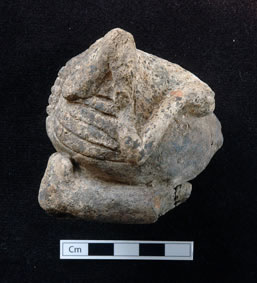
Figure 4. Clay figurine 12401.X7. Side view showing full breasts on which the hands rest and the extended stomach on one side and a skeletal representation of scapula, ribs, vertebrae and pelvis on the other other side. |
Another exciting event this year was the discovery of our first full in-situ bull’s head and horns (Figure 5). In this case, the bull’s skull had not been plastered but it had been set into the wall. In fact, there may have been a whole series of bulls above this one as we found at least 11 cattle horns plus some skulls dismantled above the one shown in Figure 5. There were traces of painting beside and beneath the skull. Adjacent to the bull’s head in Figure 5 is a collapsed and dismantled bench that was also set with a row of bull’s horns. This complex installation was found in a burned room in Building 52 in part of the 4040 Area on the north hill of the East Mound. We had already suspected that elaborate buildings of the type found by Mellaart in the south of the East Mound would also be found elsewhere on the site, but this find really proved that without any further doubt. The discovery of the installed bull’s head in a burnt room also shows us that the conditions of abandonment have a major effect on what is found. In most cases, installations are carefully dismantled before a house is abandoned. In this case, the fire and the large numbers of artifacts found on the floors, and the concentrations of seeds (naked barley, einkorn, emmer, peas, tiny crucifer seeds and almonds with kernels still in the shell) in the storage bins, all indicate a swift and unusual abandonment.
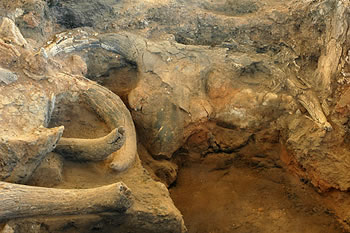
Figure 5. In-situ bull's head and horns set in one side of a bench in Building 52 in the 4040 Area. |
Overall we excavated 7 new buildings in the 4040 Area on the northern hill (see Figure *). While several of these had been disturbed by the digging of the foundation trench for a probably Roman building or tower, and by Byzantine burials, several had undergone a careful abandonment process which had resulted in the preservation of internal features. For example, in Building 57 we found that an upright plastered column was still in position, and in the same building a unique plastered fireplace with deeply incised curving, spiral-meander decoration (Figure 6). While this is the only example of such a fireplace that has been found at Çatalhöyük, it is notable that there is another building (Building 58) in the same area that has squared rather than the usual rounded fireplace or oven. There are a number of ways in which we had begun to suspect that small groups of houses with their own distinct architectural features might occur in the 4040 Area. In this same area, the same two buildings (Buildings 57 and 58) have two projecting walls on the western side of the main room, dividing this part of the room into three sections. While James Mellaart did find a few such examples in the South Area, this concentration in one area of the north part of the site does suggest local groupings of architectural styles. Burial patterns too have continued to suggest that some buildings act as places of burial for a group of houses. All this suggests local community groupings between the individual house and the large building sectors identified in the 2003 scraping in the 4040 Area.
It is also clear that apparently contemporary plans of houses on one ‘level’ at Çatalhöyük may mask significant variation in date. For example, in the 4040 Area Building 58 is stratigraphically later than its neighbour Building 55. On the basis of pottery and obsidian finds, Building 58 and adjacent buildings to the east excavated last year are later than surrounding buildings and probably date to Levels IV-II. On the other hand, Space 90 in the northern part of the 4040 strip excavated this year is dated by pottery to Levels VII-V. This variation in date will be examined further with radiocarbon determinations, but it is at least clear for the moment that adjacent houses or groups of houses can have very different dates. Indeed, some of the supposed spatial patterning identified above may be temporal. The squared ovens in Buildings 57 and 58 may both be part of a change that occurs at the top of the mound towards greater importance given to ovens (the oven in Building 57 is also decorated). A central oven was found in a late building in the 4040 strip excavated in 2004 (Building 47), and in 2005 Building 55 had painting on the wall by the oven. In 2005 also, a central hearth was found in a Level II-I building in TP, and central hearths have been found on the later West Mound. In the lower levels in the East Mound ovens tend to be rounded and to be set into or be close to south walls of main rooms. The shift in shape and location for the ovens, and their decoration, may indicate a greater centrality for domestic oven-based activities in the later levels of the site.
Other activities
An educational programme at the site sponsored by Shell and Coca-Cola has continued this year. The aim of the programme is to educate young people from the Konya region, and other areas of Turkey, about the importance of archaeology for Turkey and about Çatalhöyük. This year 500 children spent a day at the site. Each day 20 children spent the day learning about the site, doing some excavation of previously excavated earth, doing Çatalhöyük paintings and making models of Çatalhöyük houses. The programme is being run by Gülay Sert.
With funding from the Global Heritage Fund, and with the expertise of Nick Merriman and his students from the Institute of Archaeology in University College London, the Visitor Center was entirely redecorated and the exhibit remade, display panels were renewed and placed on the site, and an audio guide was produced in English and Turkish.
With help from the Çumra belediye başkanı, a car park was made across the road from the entrance to the site. This has greatly alleviated congestion in the entrance area to the site as tourist numbers have continued to increase.
We are extremely grateful to Cengiz Bektaş for his exciting designs for a Çatalhöyük museum. This captures the spirit of the site and would be made out of mud brick and located near Çumra. The task that faces us now is to raise the funding for this imaginative venture.